- Established 1982 -HOME: www.hiltonpond.org
THIS WEEK at HILTON POND Subscribe for free to our award-winning nature newsletter (Back to Preceding Week; on to Next Week) |
EARLY WINTER MIMIC THRUSHES, MISSING SNOWBIRDS, November 2023 turned out to be a fairly good month for bird banding at Hilton Pond Center, with the last of the obligate fall migrants departing and first waves of winter residents coming in. A sunbathing Gray Catbird (below) with a aluminum ring on its leg was still hanging with us on 3 November; we probably banded it a month previously. Catbirds are quite scarce here in winter--our latest-ever was on 14 December 1992, and we had just one (18 December 1999) in 32 years of the York/Rock Hill Christmas Bird Count. Nearly all our Piedmont catbirds bail out for somewhat warmer coastal areas Massachusetts south to Colombia, South America. We saw dozens of them in Belize during March on Operation RubyThroat Neotropical hummingbird expeditions.
All text, maps, charts & photos © Hilton Pond Center Gray Catbirds that do spend the winter away from the Carolina Coast forage for berries and other fruits from Poison Ivy to Staghorn Sumac--plus suet at bird feeders. Some homeowners claim their cold-weather catbirds even much on donuts and boiled potato, although we wonder how nutritious those items might be.
All text, maps, charts & photos © Hilton Pond Center Gray Catbirds are members of the Mimic Thrush Family (Mimidae) so it was interesting on the day we took the catbird photo above we also caught another mimid--a Northern Mockingbird (above) in one of our mist nets. Unlike their catbird relatives, mockingbirds tend to stay out in winter, when they can be found year round in appropriate habitats within every state in the continental U.S. and most of Mexico.
All text, maps, charts & photos © Hilton Pond Center NOTE: A third Mimic Thrush that occurs at Hilton Pond is the spot-breasted Brown Thrasher (see our file photo above)--a species that has been in steep decline locally; we saw none this week. Although the species does stay year-round in the Carolinas, its population swells in fall when breeders from the northeastern U.S. come south. We've banded 537 Brown Thrashers since 1982 at the Center, more than half in the first ten years. Gray Catbirds have been nearly twice as common (1,007 bandings), while Northern Mockingbirds are much less likely to cross our banding table (194). All text, maps, charts & photos © Hilton Pond Center WHERE ARE THE SNOWBIRDS? Folks may be surprised to hear us say one of our best birds at Hilton Pond Center in early November was a Dark-eyed Junco (formerly Slate-colored Junco, below). This was our first junco of the 2023 calendar year, and in 2022 we had only one--a rather late individual on 4 April. These are remarkably low numbers for a species called "snowbirds" because they historically came south in flocks most winters. Juncos had always been dependable at the Center from mid-October through late March, foraging on the ground for scraps dropped by other feeder birds, but that's changed drastically in the past decade or so.
All text, maps, charts & photos © Hilton Pond Center Although juncos are winter residents in the Carolinas, we suspect they are at least partly "facultative" in their migratory tendencies. In other words, unlike "obligate" migrants such as Neotropical warblers that "have to" head south when fall arrives, juncos might not migrate if winter on the northern breeding grounds is more moderate than usual. In the past, most winters probably weren't mild enough for all the juncos to stay put up north, but we suspect things are different these days with climate change. All text, maps, charts & photos © Hilton Pond Center Ornithologists have concluded that Dark-eyed Junco populations are still about the same size as always--some experts say they're among the most common species in North America--but its pretty apparent based on field observations and our 42-year banding records (above) that juncos are not migrating to Hilton Pond like they used to. If their overall breeding population is stable but their winter numbers have plummeted locally it's probably not too big a stretch that a possible explanation is that winters are increasingly warmer up north. Is climate change the culprit, or is there some other explanation? If you have one, please let us know at INFO. All text, maps, charts & photos © Hilton Pond Center COLD-WEATHER MOTH On the evening of 14 November temperatures were in the low 50s and dropping, so we were surprised to see a moth fluttering against the office window of our old farmhouse at Hilton Pond Center. When we opened the adjoining door for a closer view the moth came right in and fluttered further before landing on one of our bird banding notebooks (below). Unlike most of the relatively drab brown and gray moths attracted to our office windows, this one was a bright emerald green that almost glowed under a fluorescent desk lamp.
All text, maps, charts & photos © Hilton Pond Center Hmmm, we thought. An inch-wide moth that is emerald green in color. Could it be one of the Emerald Moths? Sure enough, a quick search in out North American moth field guide confirmed this was a Red-fringed Emerald, Nemoria bistriaria, so-called because of the thin reddish edge on its hindwings. A few other emeralds look similar, but this particular species also has two thin wavy pale lines (as above) that traverse both forewing and hindwing--hence it's alternate name of Two-striped Emerald. Note also three tan bumps on the moth's body, each surrounded by the same red as the fringe. Red-fringed Emeralds are Geometrid Moths (Geometridae) whose family name means "measures the Earth." In other words, their larvae are inchworms whose looping locomotion appears to delineate whatever they might be crawling on. In the case of this particular moth, its larvae inch across and munch upon the foliage of White Oaks, Quercus alba (below), from New Brunswick to Florida and west to Texas. Curiously the Red-fringed Emerald can also occur as an adult with wings of brown rather than green.
All text, maps, charts & photos © Hilton Pond Center After we finished with out photos, the moth spent the night on the banding notebook. Next morning when the temperature rose we placed it in an out-of-the-way bark crevice. We suspect it was already past its prime--many wing scales were worn off and there was a small hole in the left forewing--but we thought we ought return it to nature where it belonged regardless of outcome. All text, maps, charts & photos © Hilton Pond Center NOT ALL OUR VIREOS MIGRATE TO THE NEOTROPICS On 17 November we were surprised to capture a gray, green, and yellowish bird with a huge white eye ring (see photo below).We recognized it immediately as one of our rarest species at Hilton Pond Center: A Blue-headed Vireo. Three of our vireos--Red-eyed, Yellow-throated, and Philadelphia--aren't very cold-hardy and typically disappear as autumn progresses, while White-eyed and Blue-headed Vireos are a bit more hardy and do overwinter in South Carolina's Coastal Plain. Even so, the Center is pretty far inland and we seldom see Blue-headed in any season, much less winter. This week's was just our 21st banded in 42 years.
All text, maps, charts & photos © Hilton Pond Center Older field guides list the Blue-headed as "Solitary Vireo," but that's no longer the case. Based on molecular studies, Solitary was split into three separate species--Blue-headed, Cassin's, and Plumbeous Vireos. The latter two are found only in the western U.S. Although Blue-headed Vireos occur across the eastern U.S. and southern Canada, the one we banded this week was probably from a race that breeds in the Appalachian Mountains and migrates short distances.
All text, maps, charts & photos © Hilton Pond Center Our close-up mug shot of our latest Blue-headed Vireo shows a large head that accommodates big muscles that allow the bird to clamp down hard on insect prey--and on a bird bander's finger--with pain intensified by a tiny hook at the end of the bill. Posterior to the hook is a notch, followed by some little protuberances on the edge of the upper mandible. These are called "tomial teeth" and provide a shearing surface that is apocalyptic for caterpillars and other invertebrates. (NOTE: For folks who sometimes confuse vireos with warblers, the latter never have a bill hook or tomial teeth.) Come cold weather Blue-headed Vireos also dine on small fruits and berries. All text, maps, charts & photos © Hilton Pond Center HILTON POND SUNSETS "Never trust a person too lazy to get up for sunrise
Sunset over Hilton Pond, 17 November 2023 Winter was bearing down on us, but some November days were downright balmy. It was cloudy until late this afternoon when western skies began clearing just in time to gave us
Sunset over Hilton Pond, 22 November 2023 For November, the 22nd was one strange weather day. Overnight we got a desperately needed 1.86" of rain; that barely raised the pond level because the ground was so parched it absorbed the precipitation with almost no run-off. As the day progressed All text, maps, charts & photos © Hilton Pond Center Don't forget to scroll down for lists of Hilton Pond supporters and of all birds banded and recaptured during the period. Photoshop image post-processing for this page employs |
|---|
|
"This Week at Hilton Pond" is written and photographed by Dr. Bill Hilton Jr., executive director of Hilton Pond Center for Piedmont Natural History
|
|
|
Please refer "This Week at Hilton Pond" to others by clicking on this button: |
|

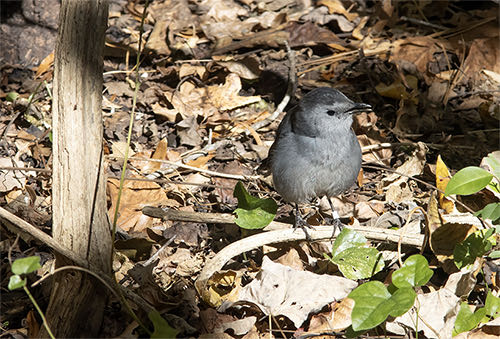
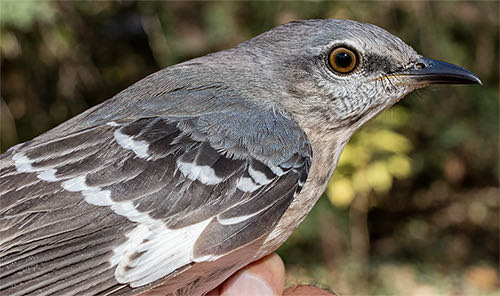
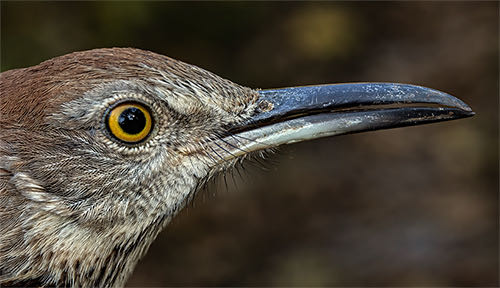
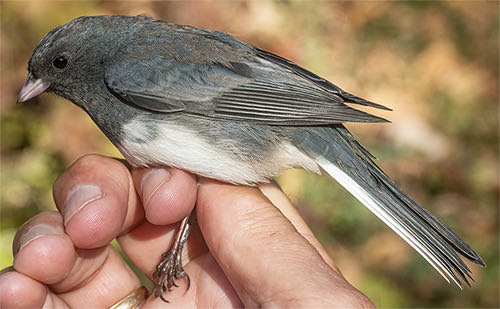
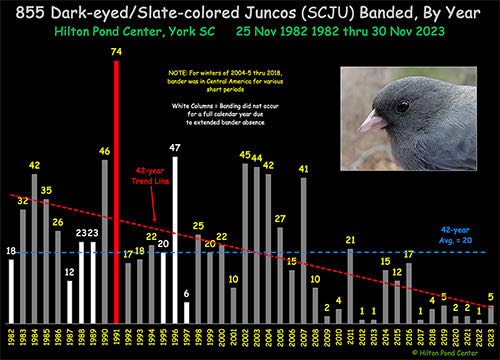
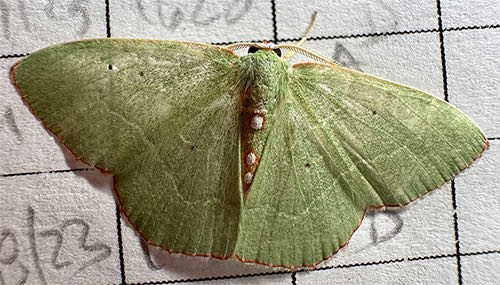

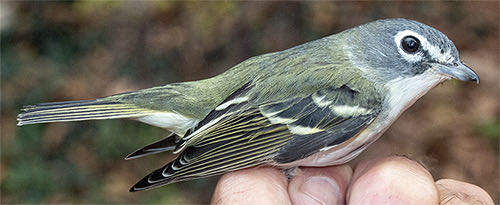
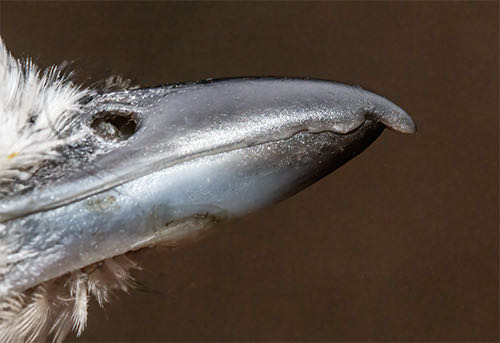
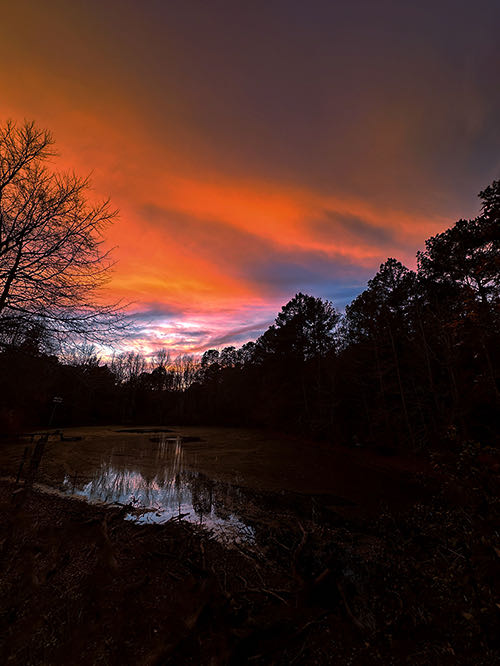
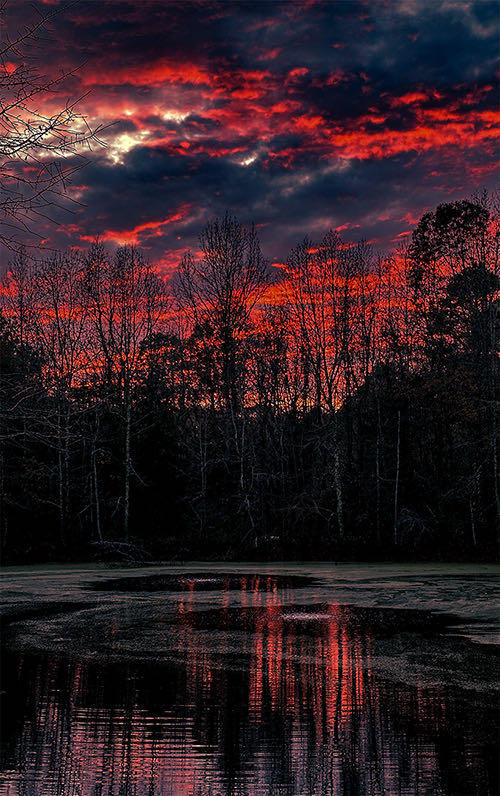









 Oct 15 to Mar 15:
Oct 15 to Mar 15: